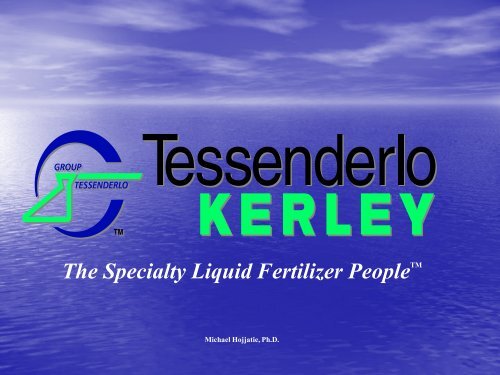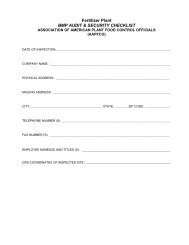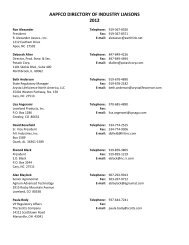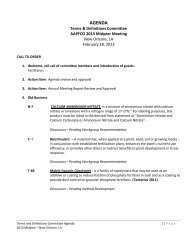Hojjatie - AAPFCO
Hojjatie - AAPFCO
Hojjatie - AAPFCO
You also want an ePaper? Increase the reach of your titles
YUMPU automatically turns print PDFs into web optimized ePapers that Google loves.
The Specialty Liquid Fertilizer People TM<br />
Michael <strong>Hojjatie</strong>, Ph.D.
Biuret Determination: A Collaborative (Or SLV) Studies<br />
Proposal<br />
<strong>AAPFCO</strong>/Method Forum<br />
San Antonio, TX<br />
February 22-23, 2012<br />
• Proposal:<br />
Liquid Chromatographic Determination of Biuret in Water-Soluble<br />
Urea-Formaldehyde Fertilizer Products, Urea Based Fertilizer<br />
Products and in Aqueous Urea Solutions
Biuret<br />
Biuret is a white solid chemical compound<br />
with the chemical formula:<br />
It is the result of condensation of two molecules of<br />
urea. This white solid is soluble in hot water.<br />
Solubility in cold water 2g/100 ml @ 25 o C.
Biuret<br />
‣ It is formed during urea production upon<br />
heating urea at 80 Degree C and higher,<br />
especially above its melting point<br />
according due to the following reaction<br />
release of ammonia:<br />
2 CO(NH 2 ) 2 → H 2 N-CO-NH-CO-NH 2 + NH 3 ↑
Urea Reaction Possible Products
Biuret In Urea Fertilizers<br />
• Urea has become the leading form of N fertilizers Worldwide.<br />
• Historically there has been concern about level of biuret in urea.<br />
• The potential adverse effect of biuret on plant growth is a concern.<br />
• Biuret is phytotoxic.<br />
• Biuret is mineralized by soil microorganisms at much lower rate<br />
then urea.<br />
• Biuret can damage seedlings.<br />
• Foliar application of high biuret urea causes phytotoxicity.<br />
• Crop tolerance to biuret varies according to the plant species, soil<br />
conditions, fertilizer placement, and method of application.<br />
• Biuret applied to soil or to plant foliage interferes with N<br />
metabolism and protein synthesis.
Adverse Effect of Biuret<br />
• A foliar application of urea prepared from prilled urea applied<br />
to young pineapple and citrus plants caused leaf injury due to<br />
biuret present in urea (G. Webster, et.al., Plant Physiol. 32 (1),<br />
60-61(1957).<br />
• Biuret: A form of nitrogen toxic to citrus and avocado<br />
leaves(A. Haas, et.al., Plant Physiol. 34, 11-12 (1954).<br />
• Biuret toxicity of urea foliage spray on citrus (W. Jones,<br />
Science, 120, 499-500 (1954).<br />
• Toxicity to pineapple plants of biuret found in urea fertilizers<br />
from different sources (W. G. Sanford, et.al., Science, 120,<br />
349-350 (1954).
Urea Nitrogen Fertilizers<br />
Urea<br />
UAN<br />
Slow Release fertilizers containing Urea:<br />
• Solid Products<br />
Sulfur Coated urea , Polymer Coated urea , Absorbed urea<br />
• Liquid Products (Urea based fertilizers)<br />
Triazone (N-Sure), CoRoN, Nitamine
C of A of Urea (Source 1)
Urea Spec Sheet (source 2)
Recommended Biuret Level<br />
Plant Physiologist recommend maximum of 0.3%<br />
biuret in urea based fertilizers for plants and crops<br />
safe applications.
Current Methods Available for Biuret Analyses<br />
<br />
AOAC 960.04 (1980) for biuret in urea<br />
Tartrate salt (NaKC 4 H 4 O 6 .4H 2 O), copper sulfate, biuret standard,<br />
spectrophotometer.<br />
<br />
<br />
<br />
AOAC 976.01 (1980) for biuret in fertilizers<br />
Based on copper complex and determination by AAs in<br />
combination with AOAC 960.04.<br />
Biuret determination by ion exchange chromatography and<br />
ninhydrin (J. Anim.Sci, 1967)<br />
Amino acid analyzer, sulfonated styrene resin, ninhydrin.<br />
UV-vis determination of biuret in hydroquinone-ureacontaining<br />
fertilizers (Nut. Cycl. In Agrosys., 1963)<br />
Based on copper colorimetric method.<br />
HPLC Method (Anal.Chem, 1982)<br />
Reversed phase HPLC in combination with copper compelexation.
‣ It is based on HPLC<br />
Proposed Method<br />
‣ Based on analyses of average of 5 samples/day for 20<br />
years internally and other Labs.<br />
‣ UV detection.<br />
‣ Acetonitrile/water mobile phase (no buffer)<br />
‣ Except for mobile phase no other solvents required.<br />
‣ It can be done in 10 minutes.<br />
‣ Low chain urea-forms could be quantified<br />
simultaneously.
AOAC Official Method 2003.14<br />
Liquid Chromatography<br />
First Action 2003<br />
HPLC Method<br />
<br />
<br />
<br />
<br />
<br />
UV absorption detector 195 nm<br />
Mobile Phase: 15% Acetonitrile, 85% water<br />
Flow rate: 1.30 ml/min<br />
Mobile phase temp: Ambient<br />
Column temperature: 30-35 o C<br />
Injection volume: 10 µl<br />
<br />
<br />
HPLC Column – A 250 x 4.6 mm amine (NH2) column<br />
with 5µ packing is used for this separation We<br />
obtained the best results using Phenomenex amine<br />
column.<br />
External or standard curves be used (Urea, Biuret,<br />
MMU, DMU, and HMTA Standards).
Biuret standard<br />
• Like any other analytical method, a good standard is<br />
necessary.<br />
• Laboratory Chemical vendors (i.e., Aldrich) sells 97-98%<br />
biuret.<br />
• Commercial samples of biuret are contaminated with<br />
organic impurities.<br />
• Special care must be taken to purify biuret by repeated<br />
crystallization and drying.
98% ALDRICH BIURET
COMMERCIAL UREA
Biuret Standard<br />
• This was prepared in house from repeated crystallization of<br />
commercially available sample (Aldrich 97%):<br />
195-196 o C (Aldrich sample 185-190 o C).<br />
• Elemental Anal :<br />
• %Theoretical: (C, 23.30; H, 4.85; N, 40.77)<br />
• % Found: (C, 23.36; H, 4.84; N, 40.87)<br />
• MP:
BIURET STANDARD
Analyses Biuret<br />
Standard Curve
HPLC of Biuret Standard & Urea
HPLC of Urea
Biuret Analyses by HPLC<br />
# Name Origin Grade % Biuret % Urea<br />
1 Source 1 28-0-0, 70%SRN 0.3 11.73<br />
2 Source 2 30-0-0 0.1 12.23<br />
3 Source 3 28-0-0, 72%SRN 0.1 7.30<br />
4 Source 4 30-0-0, 60%SRN 0.2 11.25<br />
5 Source 5 26-0-0, 33%SRN 0.2 16.92<br />
6 Source 6 29.5-0-0,60%SRN 0.1 8.26<br />
7 Source 7 30-0-0, 50%SRN 0.2 13.90<br />
8 Source 8 26-0-0-0.5B, 33%SRN 0.2 16.11<br />
9 Urea- Source 1 46-0-0 0.78 (0.5-1%)<br />
10 Urea Source 2 46-0-0 1(0.7-1.5)%<br />
11 Urea Source 3 46-0-0 0.4(0.4%)<br />
12 Urea Source 4 46-0-0 0.2 (0.1-0.5%)<br />
13 Urea Source 5 46-0-0 0.7(0.5-1%)
Urea-Form Analyses
Urea Formaldehyde Condensate Product<br />
O<br />
O<br />
Base<br />
H 2 N<br />
Urea<br />
NH 2<br />
+<br />
H<br />
H<br />
O<br />
O<br />
H 2 N<br />
NH<br />
CH 2 OH<br />
+<br />
CH 2 OH<br />
HN<br />
NH<br />
CH 2 OH<br />
DMU
UREA FORMALDEHYDE CONDENSATE<br />
PRODUCT<br />
Acidic Conditions<br />
O<br />
O<br />
Acid<br />
H 2 N<br />
NH 2<br />
+<br />
H<br />
H<br />
O<br />
O<br />
O<br />
O<br />
O<br />
H 2 N<br />
NH<br />
HN<br />
NH 2<br />
+<br />
H 2 N<br />
NH<br />
HN<br />
NH<br />
HN<br />
NH 2<br />
CH 2<br />
CH 2<br />
CH 2<br />
MDU<br />
DMTU
MMU Standard Curve
MDU Standard Curve
DMU Standard Curve
HMT Standard Curve
Triazone Formation<br />
In presence of Ammonia:<br />
O<br />
O<br />
H 2 N<br />
NH 2<br />
+ +<br />
H<br />
H<br />
NH 3<br />
O<br />
H<br />
N<br />
N<br />
H<br />
N<br />
R<br />
R = H, CH 2 NHCONH 2
Proposed Mechanism:<br />
Reaction Pathways<br />
N<br />
H N H H COH<br />
CH 2 OH N CH 2 OH<br />
H<br />
CH 2 OH<br />
Ammonia<br />
Formaline<br />
Trimethylolamine<br />
N N<br />
N<br />
HMTA<br />
+<br />
O<br />
H 2 N<br />
NH 2<br />
O<br />
O<br />
H<br />
O<br />
H N N H<br />
N N H +<br />
H 2 N NH 2<br />
N<br />
N<br />
CH 2 OH<br />
N C NH 2<br />
H O<br />
5-Hydroxymethyltriazine Urea 5-Methylureatriazone
Urea Based Liquid Fertilizers Analyses
Examples (we have done more than 4000 sample analyses)<br />
Preliminary Report of Analysis<br />
Nitamine N-Sure Formolene-Plus<br />
Total Nitrogen, Wt. %: 29.53 28.1 29.84<br />
Urea Nitrogen, Wt. %: 12.23 6.95 12.17<br />
% of Total Nitrogen from Urea: 41.42 24.7 40.8<br />
SRN, Wt., %: 17.30 21.15 17.67<br />
% of Total Nitrogen From SRN: 58.58 75.3 59.2<br />
Triazone Nitrogen, Wt. %: 9.50 10.1 10.6<br />
% of Total Nitrogen from Triazone: 32.18 35.95 35.52<br />
Biuert, Wt., % 0.10
Examples<br />
Lab Sample ID 23-079-01 23-079-02 23-079-03 Manufactured Specification<br />
Product Name Arc-1 Arc-2 Arc-3 N-SURE<br />
Grade 28-0-0 28-0-0 28-0-0 28-0-0<br />
Source Springfield, OR Springfield, OR Springfield, OR - -<br />
Batch # Formulation # 1 Formulation # 2 Formulation # 3 - -<br />
Sample Date 01/17/2012 01/19/2012 01/19/2012 Desired Limit<br />
Total Nitrogen, (Wt. %) 27.7% 28.0% 28.7% 28.0 – 28.2% 27.6 – 28.4%<br />
Urea Nitrogen, (Wt. %) 8.2% 8.3% 8.2% - -<br />
% of Total Nitrogen from Urea 29.7% 29.5% 28.7% 28 % < 31%<br />
SRN, (Wt. %N) 19.5% 19.8% 20.5%<br />
% of Total Nitrogen from SRN 70.3% 70.5% 71.3% 72 % > 69%<br />
Triazone Nitrogen, (Wt. %) 10.9% 10.1% 10.9% - -<br />
% of Total Nitrogen from Triazone 39.4% 36.0% 38.0% - -<br />
Biuret, (wt %) 0.1 0.1 0.1 0.1 % 0.25<br />
MMU, (wt %) 3.1 1.0 0.9 2.0 % < 4.0 %<br />
MDU, (wt %) 1.4 3.0 2.9 2.0 %<br />
DMU, (wt %) 0.7 0.9 0.9 0.8 % < 2.0 %<br />
MMU + DMU, (wt %) - - - - < 6.0 %<br />
HMT, (wt %) 0.2 0.4 0.9 1.0 % 4.0<br />
Total Soluble K 2 O, (Wt %) 0.8 0.5 0.7 0.6 % -<br />
Specific Gravity, ( 20/20°C) 1.286 1.274 1.287 - -<br />
pH [Full Strength) 10.1 10.6 10.6 9.0 – 10.5 8.5 – 11.0<br />
Appearance Clear, Colorless Clear, Colorless Clear, Colorless Clear, Blue -<br />
Turbidity 5 NTU 3 NTU 3 NTU 5 < 20 NTU<br />
Refractive Index (@ 25°C) 1.477 1.474 1.482 - -
Conclusion<br />
• HPLC Method Provides accurate measurement for biuret in<br />
different urea grades.<br />
• It is simple and fast when standard curve is built (
That’s all Folks









